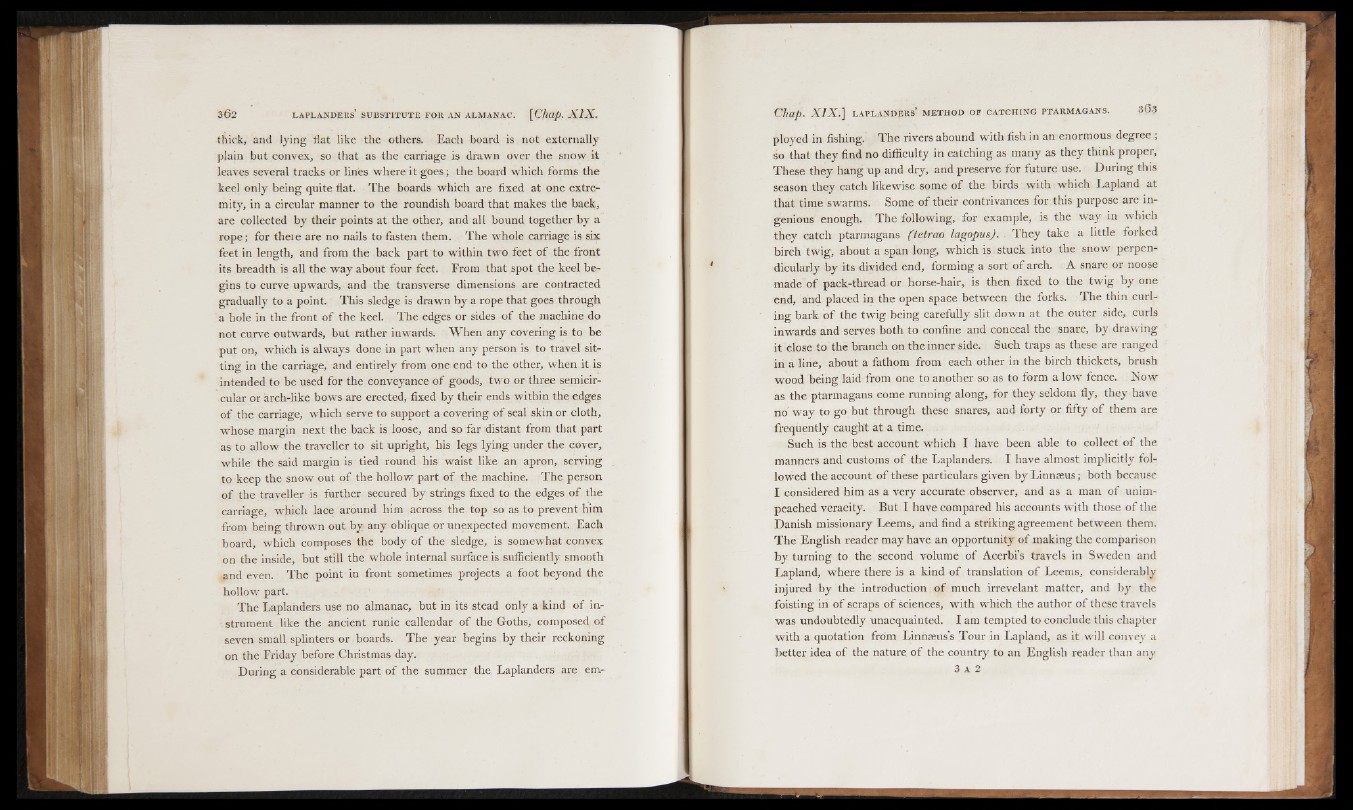
thick, and lying flat like the others. Each board is not externally
plain but convex, so that as the carriage is drawn over the snow it
leaves several tracks or lines where it goes; the board which forms the
keel only being quite flat. The boards which are fixed at one extremity,
in a circular manner to the roundish board that makes the back,
are collected by their points at the other, and all bound together by a
rope; for there are no nails to fasten them. The whole carriage is six
feet in length, and from the back part to within two feet of the front
its breadth is all the way about four feet. From that spot the keel begins
to curve upwards, and the transverse dimensions are contracted
gradually to a point. This sledge is drawn by a rope that goes through
a hole in the front of the keel. The edges or sides o f the machine do
not curve outwards, but rather inwards. When any covering is to be
put on, which is always done in part when any person is to travel sitting
in the carriage, and entirely from one end to the other, when it is
intended to be used for the conveyance of goods, two or three semicircular
or arch-like bows are erected, fixed by their ends within the edges
of the carriage, which serve to support a covering of seal skin or cloth,
whose margin next the back is loose, and so far distant from that part
as to allow the traveller to sit upright, his legs lying under the cover,
while the said margin is tied round his waist like an apron, serving
to keep the snow out of the hollow part o f the machine. The person
of the traveller is further secured by strings fixed to the edges of the
carriage, which lace around him across the top so as to prevent him
from being thrown out by any oblique or unexpected movement. Each
board, which composes the body of the sledge, is somewhat convex
on the inside, but still the whole internal surface is sufficiently smooth
and even. The point in front sometimes projects a foot beyond the
hollow part.
The Laplanders use no almanac, but in its stead only a kind of instrument
like the ancient runic callendar of the Goths, composed of
seven small splinters or boards. The year begins by their reckoning
on the Friday before Christmas day.
During a considerable part of the summer the Laplanders are employed
in fishing. The rivers abound with fish in an enormous degree ;
so that they find no difficulty in catching as many as they think proper,
These they hang up and dry, and preserve for future use. During this
season they catch likewise some o f the birds with which Lapland at
that time swarms. Some o f their contrivances for this purpose are ingenious
enough. The following, for example, is the way in which
they catch ptarmagans (ietrao lagopus). They take, a little forked
birch twig, about a span Jong, which is stuck into the snow perpendicularly
by its divided end, forming a sort of arch. A, snare or noose
made of pack-thread or horse-hair, is then fixed to the twig by one
end, and placed in the open space between the forks. The thin curling
bark of the twig being carefully slit down at the outer side, curls
inwards and serves both to confine and conceal the snare, by drawing
it close to the branch on the inner side. Such traps as these are ranged
in a line, about a fathom from each other in the birch thickets, brush
wood being laid from one to another so as to form a low fence. Now
as the ptarmagans come running along, for they seldom fly, they have
no way to go but through these snares, and forty or fifty of them are
frequently caught at a time.
Such is the best account which I have been able to collect o f the
manners and customs o f the Laplanders. I have almost implicitly followed
the account of these particulars given by Linnaeus; both because
I considered him as a very accurate observer, and as a man of unimpeached
veracity. But I have compared his accounts with those o f the
Danish missionary Leems, and find a striking agreement between them.
The English reader may have an opportunity of making the comparison
by turning to the second volume of Acerbi’s travels in Sweden and
Lapland, wrhere there is a kind of translation of Leems, considerably
injured by the introduction; of much irrevelant matter, and by the
foisting in of scraps of sciences, with which the author o f these travels
was undoubtedly unacquainted. I am tempted to conclude this chapter
with a quotation from Linnaeus's Tour in Lapland, as it will convey a
better idea of the nature o f the country to an English reader than any
3 a 2